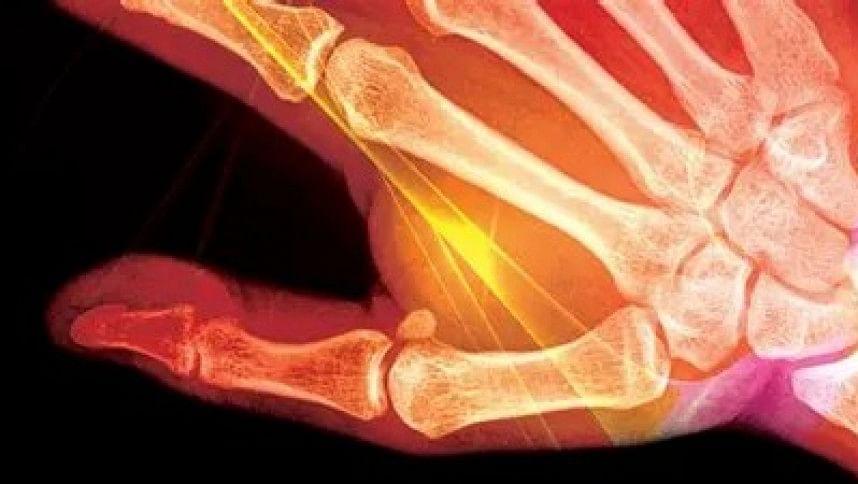Musculoskeletal Disorders: signs and symptoms to lookout for

To say that neck and back pain are minor speed bumps in the process of ageing would be quite an understatement. Rheumatoid illnesses pack a cocktail of conditions that start off with one area of the body and gradually spill onto other parts, thus impacting our functionality and eventually productivity. The diseases in this area are rather intersectional, as a result, it affects gut and mental health, muscles as well as bones. Furthermore, day-to-day habits also aggravate the conditions unless necessary steps to recovery are not sought out immediately.
Professor Dr Md Mujibur Rahman, MMBS, MD, FCPS, Rheumatology Fellow, Harvard Medical School (USA), Internal Medicine and Rheumatology Specialist, Professor, Internal Medicine Department, Bangabandhu Sheikh Mujib Medical University (BSMMU), Dhaka, shares that musculoskeletal pain and symptoms are very common among patients in Bangladesh.
Some are non-specific back pain, soft tissue rheumatism like pain in the heel, shoulder, and other regions. Although they are not very serious, they do however cause distress to people. He also states that there are some symptoms in patients that are often termed as 'red flags.'
"If a person above the age of 50 experiences lower back pain accompanied by a fever, and has lost weight, they must immediately consult their medicine specialist," says Dr Rahman.
Few specific arthritic ailments often impact both men and women in our country, irrespective of age. Rheumatoid arthritis is often found in women — the patients experience pain in both small and large joints, which includes hands and feet.
Ankylosing spondylitis is a condition that affects the vertebral column. In long-standing cases, it prevents patients from standing straight as a result of developing a stooped-over posture. This is associated with lower back pain. Some arthritic conditions are often associated with skin conditions such as psoriasis leading to psoriatic arthritis.
Another disease that primarily affects women is systemic lupus erythematosus (SLE) which consists of arthritis and skin manifestation with some underlying systemic problems.
Although gout is not common in people, if it does occur, treatment should consist of a strict diet without foods that can increase the level of uric acid in the body. Osteoarthritis stems from the knees and mostly impacts the elderly. Although women are mostly affected by this, men too suffer from this condition and so do people who are lean or obese.
Lastly, fibromyalgia he says is a condition where patients experience diffuse widespread pain in the whole body running below the umbilicus (navel) and also above.
"Patients diagnosed with the condition often have anxiety, stress, or depression which results in increasing complaints."
Dr Md Mujibur explains that younger women are often at the receiving end and sometimes men suffer from this condition too.
Environment and lifestyle often play a significant role in making an illness go from bad to worse.
"Musculoskeletal pain such as osteoarthritis is often affected by habits such as frequently using the stairs and putting a lot of pressure on the knees, or gaining excess weight due to consumption of certain foods. Other factors include walking on broken and uneven footpaths and roads," Dr Rahman explains.
There are separate treatment protocols that are internationally recognised to identify if a person is actually suffering from rheumatoid arthritis, ankylosing spondylitis, or SLE to find out relevant treatments.
Dr Md Mujibur suggests that at first, patients need to identify if their conditions fall under the category of 'specific diseases.' Once they have identified these problems, they need to make lifestyle changes such as weight reduction and their doctors might prescribe a small number of painkillers.
Doctors identify musculoskeletal conditions using the certain criterion for classifying diseases.
"If a young woman shares that she has arthritis in the joints of her hands, then local doctors tend to diagnose it as rheumatoid arthritis. If a young man experiences pain in his knees or ankles, then it might fall under the spondyloarthritis group. These details, however, may be complex for the layman to understand," he elaborates.
Since these conditions are dependent on recovery more than cure, Dr Md Mujibur suggests that if the conditions are in control, then patients should follow up with consultations every three to six months. But if the condition persists for longer, then it's best to visit the doctor every two to three weeks.
Given that lifelong diseases are mentally and emotionally taxing as they are physical, Dr Md Mujibur says that it's important to identify the disease and also reassure patients in accordance with that.

 For all latest news, follow The Daily Star's Google News channel.
For all latest news, follow The Daily Star's Google News channel. 








Comments